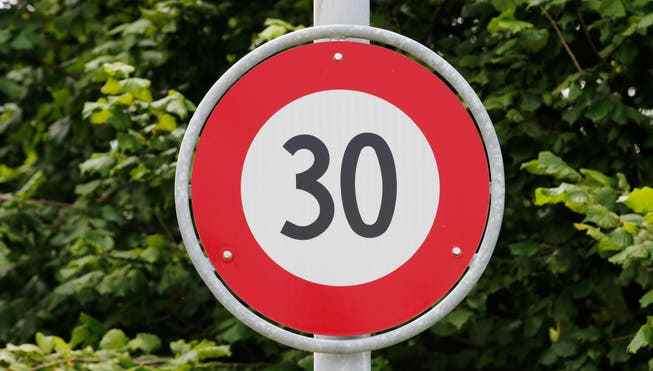Tempo 30 on 150 kilometers of road – that is the plan of the city council. But he has received criticism from within his own ranks.
Tempo 30 is to be greatly expanded on the streets of the city of Zurich.
As a driver, it’s easy to lose track of things on the streets of Zurich: is the speed limit 30 here, or am I already in the 50 zone again? The road network is a patchwork quilt because many different interests collide: those of drivers, cyclists, residents and users of public transport.
A year and a half ago, the city was reportedly planning a radical move. Tempo 30 should be introduced on almost all roads – even on main traffic axes. In doing so, the city council drew particular anger from the canton, while the Department of Economic Affairs was concerned about the slowdown in public transport. As a result, the city moved away from the original plan and presented its new “speed plan” last December. As a result, each road is checked on a case-by-case basis to determine whether a speed reduction actually makes sense.
The basic goal remains the same: Tempo 30 should be greatly expanded. This is mainly for reasons of noise protection. Today, around 140,000 people in Zurich are exposed to road noise above the statutory limit values. There is a need for action for the city, not only for reasons of health protection, but also because various construction projects are blocked due to the noise. In many cases, the speed reduction is not sufficient to fall below the limit values.
The speed is to be reduced on 150 kilometers of road over the next ten years. In some cases, the speed limit only applies at night, in other cases it must be checked whether the public transport could run on its own route. Because Tempo 30 also slows down public transport.
So far the vision of the city. The difficulty, however, is its implementation. On Tuesday, the city council presented a plan on how the new speed regime is to be implemented step by step. In principle, road sections were prioritized “where a large number of people affected by noise can be relieved”, as the city writes in a statement. In addition, those roads should be preferred on which public transport is not affected. For example on Seebahnstrasse (section Hohlstrasse to Badenerstrasse) or on Dörflistrasse (section Berninaplatz to Tramstrasse). Tempo 30 should apply there by autumn 2024 at the latest.
15 million francs additional costs for public transport
Things are more complicated where public transport is affected and, for example, the timetable has to be adjusted or additional vehicles have to be procured. The individual journey by tram or bus may not even take a minute longer because of the 30 km/h speed limit. Calculated over the whole day, this adds up on the tram or bus route. If the previous cycle is to be maintained, additional vehicles are sometimes required. And that’s in the money. The VBZ expect additional costs of 15 million Swiss francs.
For the time being, these will be borne by the city, and a corresponding application has been submitted to Parliament. However, the city council is of the opinion that the canton should bear the costs. After all, this is also tied to the noise protection requirements, says civil engineering director Simone Brander (SP) on request. So that the implementation of Tempo 30 does not fail because of the financing, the city council wants to secure this temporarily.
In any case, the implementation is already complicated enough. If public transport is affected, the cantonal timetable procedure must be followed in addition to adjusting the traffic regulations. Because the city is entering “new territory” with this, some sections of the road are now being treated as pilot projects. For example the Schwamendingenstrasse (section Dörflistrasse to Winterthurerstrasse). Tempo 30 is to be introduced there by the end of 2026, as well as on Hohlstrasse (Feldstrasse to Hardplatz) or Forchstrasse (Kreuzplatz to Burgwies). On the latter routes, however, the new regime only applies at night.
“We’re late, that can’t be sugarcoated”
The city wants to use not only 30 km/h, but also the use of low-noise coverings so that the immission limit values are observed in the future. The increase in electromobility will also reduce noise. The city is also hoping for a “reduction in the volume of motorized private transport” in the longer term. All of this should ensure that by 2060 nobody will be unduly bothered by traffic noise.
This is taking far too long for the Swiss Traffic Club (VCS), after all, since 1985 the federal government has had a mandate to protect people and the environment from road noise. Zurich is finally making concrete and systematic efforts to improve noise protection, writes the VCS in a statement. But the “sluggish opinion-forming process in the city council” meant that many residents would have to wait a long time for more noise protection on many streets.
Councilor Brander can understand the criticism: “We’re late, that can’t be sugarcoated. But we’re moving forward now.”
However, how fast it goes also depends on whether Tempo 30 is blocked by objections. Or through politics: In May, the SVP in the city submitted the initiative “No Tempo 30 on main traffic routes”. And in November, the FDP and SVP submitted an initiative against a nationwide 30 km/h speed limit at cantonal level. The initiators argue that public transport should not be slowed down by the speed reduction.

